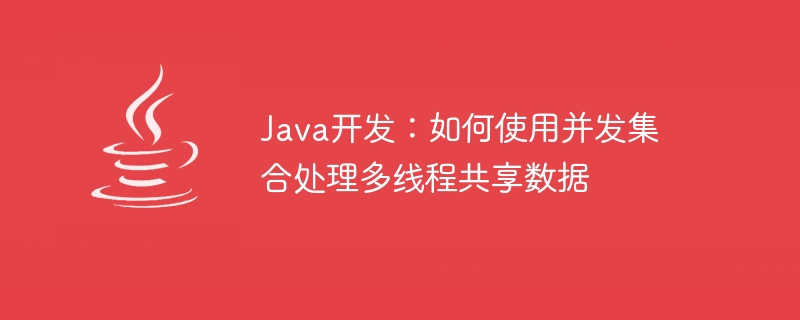

Java development: How to use concurrent collections to process multi-threaded shared data
Multi-threaded programming is one of the common requirements in modern software development. In a multi-threaded environment, multiple threads accessing and operating shared data simultaneously may lead to data inconsistency and race conditions. In order to solve these problems, Java provides some concurrent collection classes that can help us safely handle multi-threaded shared data.
In this article, we will introduce the commonly used concurrent collection classes in Java and show how to use them to handle multi-threaded shared data. Below we will introduce the basic usage of concurrent collection classes and provide some code examples to illustrate their use.
ConcurrentHashMap is a thread-safe hash table implementation provided by Java. It allows multiple threads to read and write data simultaneously without causing data inconsistency or race condition issues. The following is an example of using ConcurrentHashMap to process multi-threaded shared data:
import java.util.concurrent.ConcurrentHashMap;
public class ConcurrentHashMapExample {
private static ConcurrentHashMap<Integer, String> map = new ConcurrentHashMap<>();
public static void main(String[] args) throws InterruptedException {
Thread thread1 = new Thread(() -> {
for (int i = 0; i < 1000; i++) {
map.put(i, "value" + i);
}
});
Thread thread2 = new Thread(() -> {
for (int i = 0; i < 1000; i++) {
map.put(i, "new value" + i);
}
});
thread1.start();
thread2.start();
thread1.join();
thread2.join();
System.out.println("Size of map: " + map.size());
}
}In this example, we create a ConcurrentHashMap and use two threads to insert 1000 data items into it. Due to the thread safety feature of ConcurrentHashMap, multiple threads can perform put operations at the same time without causing data loss or inconsistency.
CopyOnWriteArrayList is a thread-safe ArrayList implementation provided by Java. It ensures thread safety by copying the entire list on every write operation. The following is an example of using CopyOnWriteArrayList to process multi-threaded shared data:
import java.util.List;
import java.util.concurrent.CopyOnWriteArrayList;
public class CopyOnWriteArrayListExample {
private static List<Integer> list = new CopyOnWriteArrayList<>();
public static void main(String[] args) throws InterruptedException {
Thread thread1 = new Thread(() -> {
for (int i = 0; i < 1000; i++) {
list.add(i);
}
});
Thread thread2 = new Thread(() -> {
for (int i = 0; i < 1000; i++) {
list.add(i);
}
});
thread1.start();
thread2.start();
thread1.join();
thread2.join();
System.out.println("Size of list: " + list.size());
}
}In this example, we create a CopyOnWriteArrayList and use two threads to add 1000 elements to it. Similar to ConcurrentHashMap, the thread safety feature of CopyOnWriteArrayList allows multiple threads to perform add operations at the same time without causing data loss or inconsistency.
In addition to ConcurrentHashMap and CopyOnWriteArrayList, Java also provides other concurrent collection classes, such as ConcurrentLinkedQueue, BlockingQueue, etc., which are suitable for different demand scenarios. By using these concurrent collection classes, we can easily handle multi-threaded shared data and avoid data inconsistency or race conditions.
To summarize, dealing with multi-threaded shared data is a challenging task, but using the concurrent collection classes provided by Java can simplify the process. When writing multi-threaded applications, we should make full use of these concurrent collection classes to ensure data security and consistency in a multi-threaded environment.
The above is the detailed content of Java development: How to use concurrent collections to process multi-threaded shared data. For more information, please follow other related articles on the PHP Chinese website!
 What are the office software
What are the office software
 Introduction to the meaning of cloud download windows
Introduction to the meaning of cloud download windows
 What to do if temporary file rename fails
What to do if temporary file rename fails
 What to do if avast reports false positives
What to do if avast reports false positives
 The difference between get and post
The difference between get and post
 Telecom cdma
Telecom cdma
 What should I do if the CAD image cannot be moved?
What should I do if the CAD image cannot be moved?
 fakepath path solution
fakepath path solution
 Check if the port is open in linux
Check if the port is open in linux




